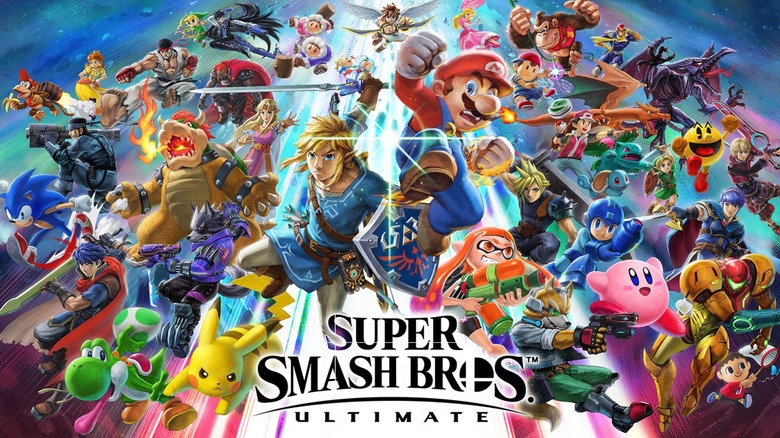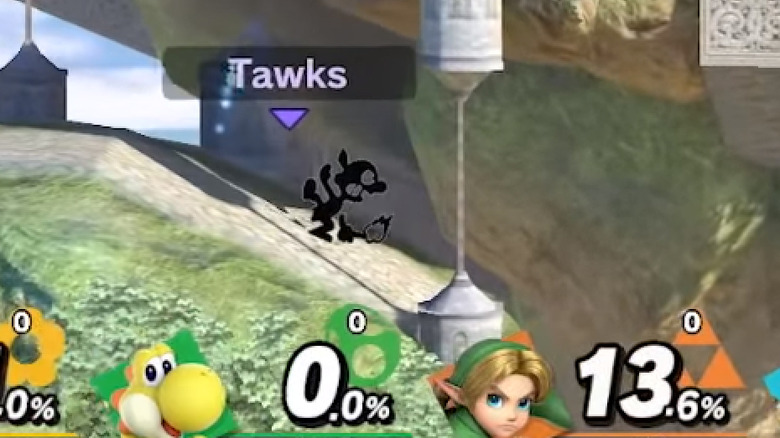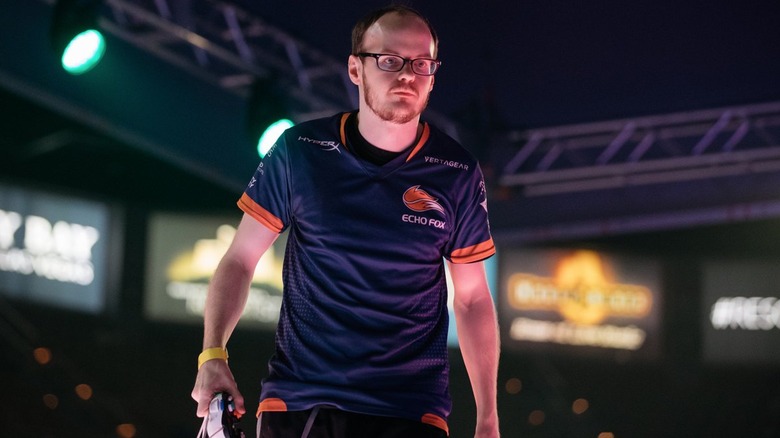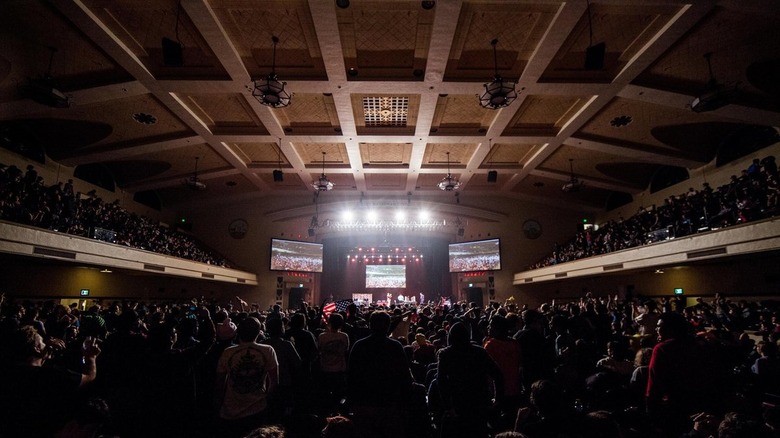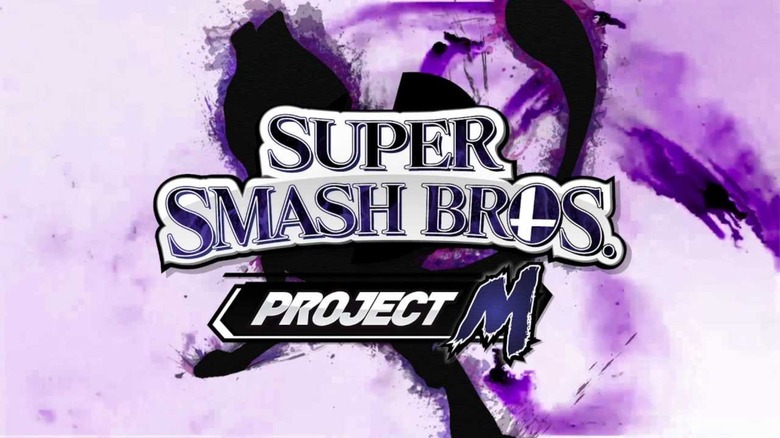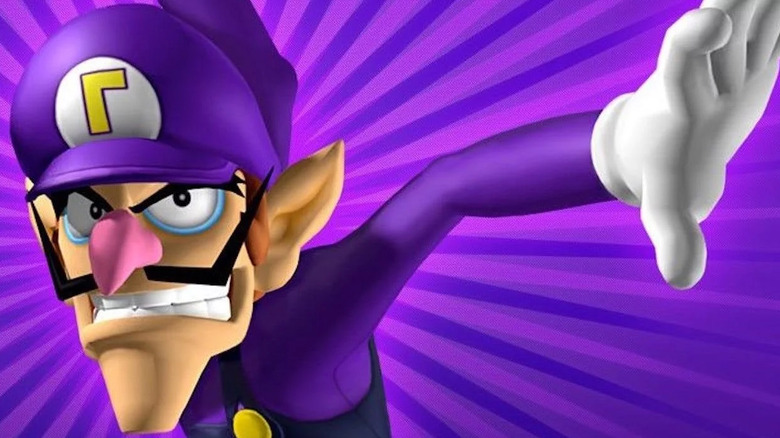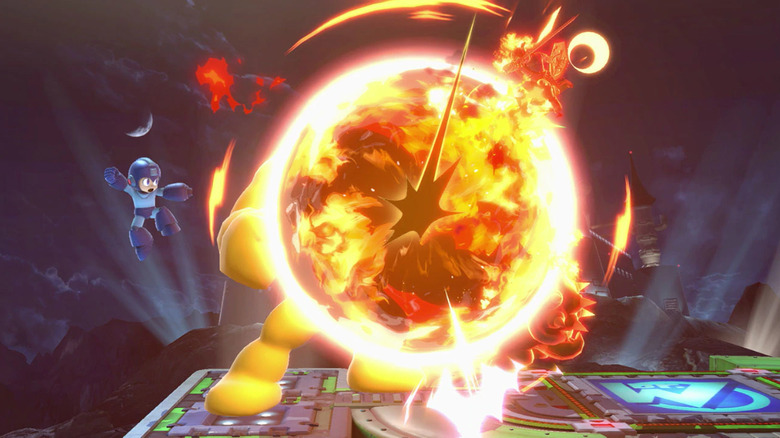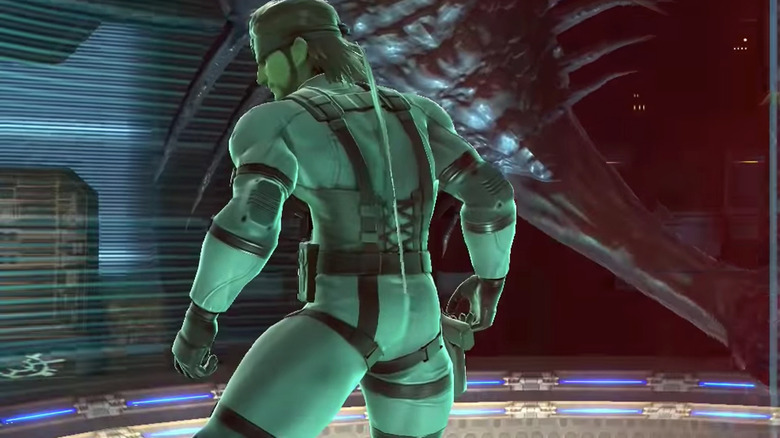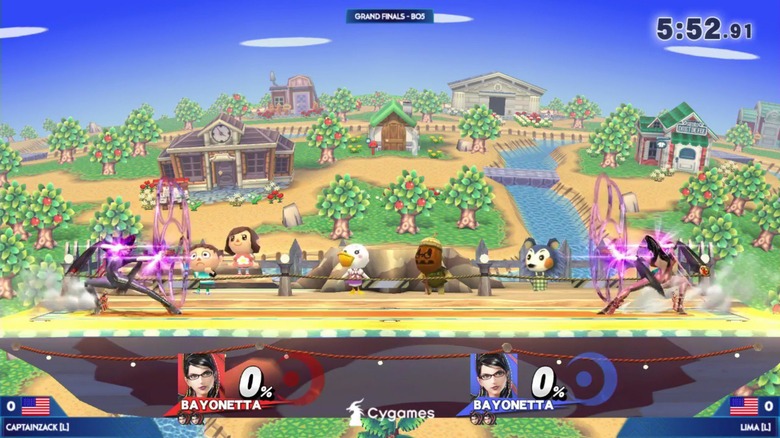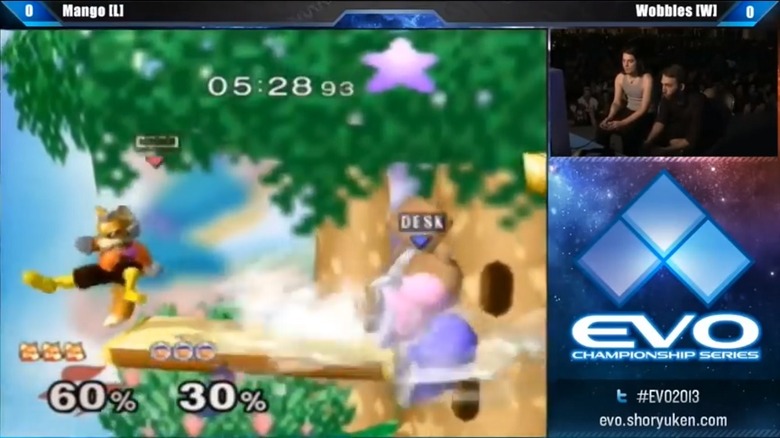Biggest Scandals In Smash Bros. History
Nintendo might be a family-friendly company, but it has experienced its fair share of controversy. Surprisingly, a lot of it has seemed to come from the Super Smash Bros. franchise, a series of games that has made its name on creating dream-like scenarios for fans. The series has helped, or at least attempted to help, solve many of the "who would win?" arguments that gamers have been having since Mario and Kirby were stars of their respective titles.
Unfortunately, conflict seems to follow Super Smash Bros. long after the characters have left the stage. The game series has had a number of different scandals both in-game and out, and we've compiled a collection of some of the most shocking events to take place within one of the best fighting game franchises in history.
Mr. Game & Watch's racist wardrobe
In November 2018, Nintendo accidentally ran a Japanese advertisement for Super Smash Bros. Ultimate that featured a troubling representation of Mr. Game & Watch. In the still, which was later circulated all over social media, Mr. Game & Watch is dressed in stereotypical Native American attire, complete with a loincloth and feather, and has had his color scheme shifted from black to red.
Obviously, that was an issue. Nintendo came under fire from Native American populations, correctly calling out the company for including something so offensive. The attire was a call back to a previous version of the Game & Watch series, called Fire Attack, which saw the player defend an Old West fort against racist portrayals of Native Americans who were attempting to burn the fort down.
Fire Attack was produced in 1982, and even though it certainly wasn't okay then, it's even more unacceptable now given how far we've come in gaming regarding acceptance and cultural diversity. Even weirder was the fact that Nintendo had already edited the racist silhouette in a remaster of the game when it was part of the Game & Watch Gallery 4 compilation, which makes the attire's inclusion even more head-scratching.
Luckily for those involved, it was a relatively easy fix for Nintendo, which will patch the image out of the game. Apparently, the image didn't even make it into the Western versions of Super Smash Bros. Ultimate, making its inclusion one of the most bizarre incidents in Smash Bros. history and an awkward, messy moment for a company that prides itself on its reputation.
Mew2King takes the crown for relationship drama
The Super Smash Bros. franchise is no stranger to relationship scandals. Professional player Jason "Mew2King" Zimmerman, widely regarded as one of the greatest Smash Bros. players of all time, ended up embroiled in one of the most convoluted romantic controversies in gaming history.
Zimmerman thought he was in a relationship with Cynthia Changa, aka Cynthia Bunnay, a woman who worked public relations for the team he was a part of, Most Valuable Gaming (MVG). When she was released by MVG, the company cited poor performance and a whole slew of other issues. But rumors swirled about Bunnay being unfairly targeted by MVG because she was never actually interested in Zimmerman. Others, meanwhile, suggested she'd exploited him and his team for the job in the first place.
It gets even messier. It turned out that Zimmerman apparently had suggested Bunnay for the job, because he wanted to pursue a romantic relationship with her — not necessarily because he felt she was the most qualified. Bunnay, on the other hand, allegedly manipulated multiple people with relationship promises, among other melodramatic accusations.
Once private photos of Bunnay appeared on the internet, fans accused Zimmerman of leaking them. He denied the allegations, but no one knows for sure. Regardless of who caused what, the photo leak was criticized by everyone involved, and Zimmerman and Bunnay have since moved on from the drama while remaining active members of the industry, albeit with both having somewhat tainted public images following the incident.
Small tweak, big backlash
The fighting game community (FGC) is a small, tight-knit group based around whatever their favorite titles in the genre are. The remarkable thing about the FGC, though, is that a number of its professional players can maintain excellence at multiple different games during the same time period.
That just doesn't happen in other genres — there will never be someone who plays League of Legends and Dota 2 at the same high level — and it also means that the default rules for tournament play are typically left unchanged in every event. Unfortunately, that's not exactly what happened during a fighting tournament named Genesis 4. For some reason, the damage ratio in Super Smash Bros. for Wii U had been changed from the default 1.0x to 0.9x mid-way through the tournament without any explanation. This was only discovered toward the end of a set between Rei "Komorikiri" Furukawa and "Captain Zack" Lauth that saw Komorikiri lose 3-1.
The crowd, upon realizing what had happened, chanted "Run it back!" throughout the hall, and the tournament organizers seemed to agree initially. However, they finally decided they would only replay the final game, resuming the series with Zack in a 2-1 lead.
Komorikiri took an extended break after the debacle, while another player affected asked for compensation. The error potentially cost both players a shot at $10,000. Luckily, the controversy only lasted for the weekend, as the tournament organizers did in fact offer compensation to the players affected.
Developing a new identity
The Smash Bros. community is pretty wild, all things considered. For a group of people who are brought together by the common bond of a game that pits family-friendly characters against each other, the scandals that emerge from Smash Bros. fans are as complex as anything you might find on television.
Case in point: the Smash Bros. community experienced a long-con featuring identity fraud that went on for three years. A woman, referred to as Katy despite having multiple aliases during this story, convinced an entire community of fans of the Project M mod for Smash Bros. that she was its developer, a reclusive individual who had never identified themselves to anyone.
Katy, of course, denies that she ever impersonated the famous developer, who goes by Magus online. Yet a group of roommates have confirmed she moved in with them under the pretense that she had developed Project M, and continued to live with them while pretending to make coding changes to the mod. The sheer amount of commitment the lie took is noteworthy: Katy had to live it for three years, and somehow her roommates only found out about the lies toward the tail-end of their time together.
The roommates, Alex Wallace and Adrian Nieto, were actually two film students who were creating a documentary about how Project M was made. They were two of the most well-versed people on the subject, and somehow, someway, Katy had fooled them until Mew2King himself, who had corresponded with Magus previously, confirmed she was not the developer.
They confronted her, and she disappeared. Wallace and Nieto don't know where she ended up, and she's since declined to comment on the subject outside of denying she ever impersonated Magus. It's one of the creepiest stories in any video game community, hands down.
No Waluigi
What a long, strange trip it has been for Waluigi up until this point. The man who was routinely referred to as the worst character in the history of Super Mario Bros. games has now become something of an icon, with millions (okay, maybe tens of thousands) supporting his inclusion in every Nintendo game.
The game people want Waluigi in the most, however, is Super Smash Bros. Ultimate, but that once again isn't happening. During the E3 2018 Nintendo Direct, Ultimate got its longest time on screen to date, and announced several new characters. None of them were Waluigi, and then the internet went wild.
Fans began starting petitions to have the character included in Super Smash Bros. Ultimate, with some of those petitions getting thousands of signatures. People began penning articles accusing Nintendo of being cowards, afraid of their most powerful character. There were memes everywhere, and the roster hadn't been fully revealed yet. The inclusion of Waluigi became a running gag, but also the source of a lot of frustration within a Smash Bros. community that felt its favorite picks for roster inclusions were being ignored.
The discourse surrounding the decision turned sour, though, when fans began harassing game director Masahiro Sakurai with inappropriate content. Most of the community hated it and stood in vocal support of Sakurai, but that kind of behavior and the controversy it stirred up within the community could be the reason we never see Waluigi in Super Smash Bros. Ultimate, even with DLC characters coming in 2019.
Way to go, internet. You ruin everything.
A Nightmare (for tournament organizers)
If these incidents have proven anything, it's that the Smash Bros. community is overall a positive influence on the game and its direction but is beset on all sides by toxic behavior from a smaller subsection of the group. That notion necessitated the creation of something called the Harassment Task Force, a team made up of community influencers, tournament organizers, and fans, with the goal to clean up the scene so that it is welcoming to new players.
It didn't take long for the new team to strike: they near-immediately dug up some troubling accusations about Vikram "Nightmare" Singh, a Canadian pro who had already developed an under-the-radar, word of mouth reputation for inappropriate behavior at tournaments.
Singh was involved in a case that accused him of having a sexual relationship with an underage girl, with a friend of his stating that he had received a criminal charge as well. While this was in the past, Super Smash Bros. event organizers had just adopted a code of conduct for tournaments that would see Singh retroactively banned from attending or playing in tournaments.
Singh retaliated by threatening a lawsuit, and the community began to worry that tournament organizers, who barely break even on most Smash Bros. tournaments, wouldn't be able to afford legal action if it came to that. Luckily, it appears Singh has since dropped the case, disappearing from Twitter under his usual handle altogether.
The controversy of his retroactive banning lingers, however, with some members of the community feeling it was wrong to target him years after his misconduct. For what it's worth, though, the Harassment Task Force has been well-received, so it seems the Nightmare is over.
Two-dimensional troubles
Not every scandal in Super Smash Bros. is depressing, thankfully. Sometimes fans just want their favorite body part on a character from a previous iteration to remain as three-dimensional as it was. Sometimes, Nintendo changes that character's butt to look like a flattened cardboard box.
Solid Snake's behind was a popular meme in Super Smash Bros. Brawl, as the developers seemed to have gone out of their way to make sure people knew Snake was hitting the gym in between complicated war stories. Then, when Snake made his appearance in Super Smash Bros. Ultimate, people immediately noticed that something had changed: Snake had a serious case of two-dimensional glutes, and his many fans were unhappy.
How unhappy? Fans genuinely described the change as nerfing Snake, even though it obviously didn't impact his viability as a fighter. Some of them even tweeted at David Hayter, the actor who gives Snake his recognizable gravelly voice, to contact Nintendo to ask them to change it back.
The saddest part of this controversy is that nothing has been done. It appears we will be stuck with a version of Solid Snake that is incongruent with Hideo Kojima's vision of the well-toned man, and fans will have to look towards mods and community art to relive the glory that was the Brawl version of Snake's buns.
Bayonetta breaks Smash Bros.
Broken characters are never fun. When a competitive game becomes unbalanced, the community begins to resent it, and often they express that resentment in some unhealthy ways, directing it at developers, players who use the character, and the game itself. Such was the case earlier this year at EVO 2018, when the Super Smash Bros. community was treated to what might be one of the least balanced but still legal characters in recent major tournament memory.
Bayonetta has been poorly received in Brawl, with many community members being outspoken about the relative ease with which people can play her and succeed compared to other characters. This came to a head at EVO 2018, which saw some tournament and community favorites knocked out by lesser-known players using Bayonetta. Fans would boo when Bayonetta won, sometimes resulting in competitors flipping off or negatively interacting with the crowd. With fans already resenting the character, the worst case scenario happened: a finals that featured a Bayonetta mirror.
Booed as they walked on stage, the two players, CaptainZack and Bharat "Lima" Chintapall decided to approach their final reset by staring at each other and not attacking as a parting shot at the vocal audience. The crowd was very upset, and tournament organizers had to step in and force them to continue their match.
The real kicker in all of this, though, is that both CaptainZack and Lima are under 18. Even if they were behaving immaturely, the crowd booing them for using an overpowered character looked even worse, and the community rallied against the EVO crowd in support of the players. Hopefully Bayonetta gets balanced in Ultimate to avoid similar incidents in the future.
Nintendo hates esports
Believe it or not, there was a point in time in Nintendo's history where the company thought it would be bad for major tournaments to stream its games being played competitively. Even more shocking? It was only five years ago when the Japanese video gaming giant made one of its bigger blunders in that regard, inciting a passionate fanbase to defend the game it had largely built up on its own without Nintendo's help.
EVO 2013 saw the grand finals of the Super Smash Bros. Melee event threatened by Nintendo. The company wanted EVO to take down the stream, believing it to be infringement or otherwise bad publicity. Little did the company know that requesting the grand finals to be played off stream was a much worse look for it: Super Smash Bros. Melee was only at EVO that year because its community had managed to raise over $100,000 for breast cancer research, meeting an incentive for the game's involvement.
Fan backlash was predictably vicious, with online commenters absolutely incinerating Nintendo for the company's tone-deaf approach to the Smash Bros. community. As major news outlets began to pick up and run with the story, Nintendo was forced to back down, but not before stubbornly sticking to its stance for way longer than was reasonable. There's a reason so many veterans of the Smash Bros. scene are wary of Nintendo, and a lot of that distrust stems from this specific moment.
Let's hope Nintendo learns to market its games a little bit better with Super Smash Bros. Ultimate. With so much anticipation regarding the game, it would be unwise for the company to miss a chance to build its own esports scene. For a company that's usually so innovative, Nintendo has been incredibly reluctant to move into the future of streaming.

